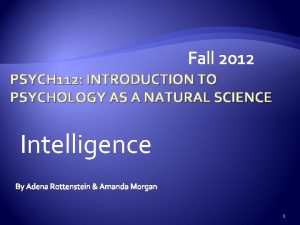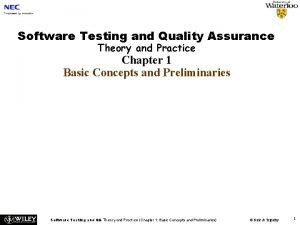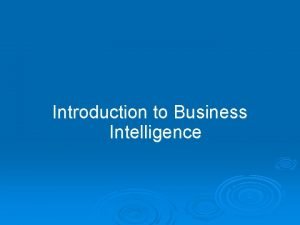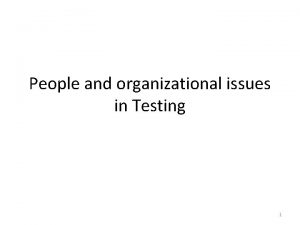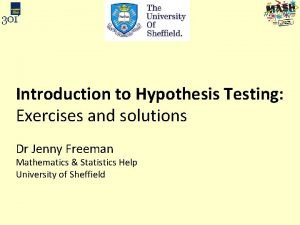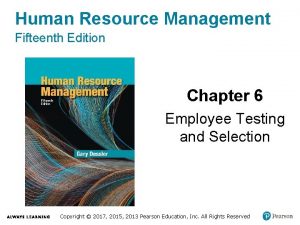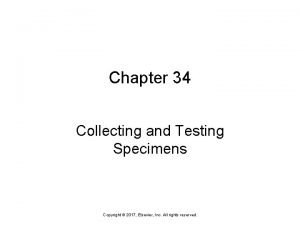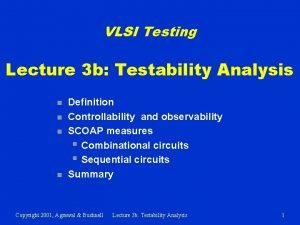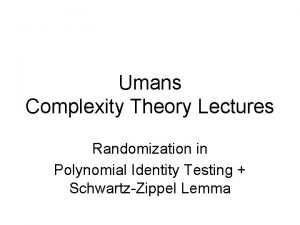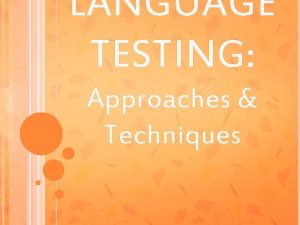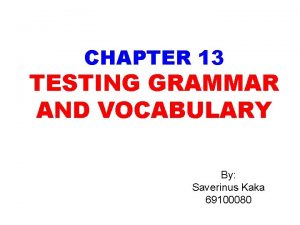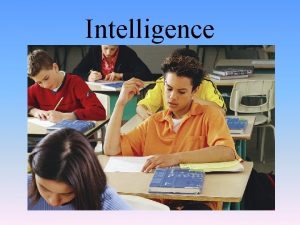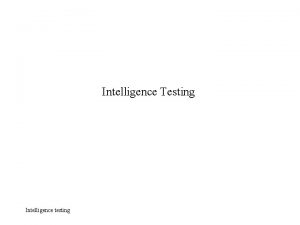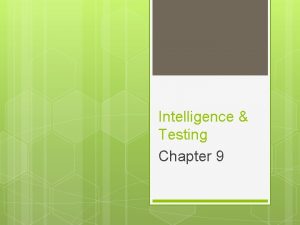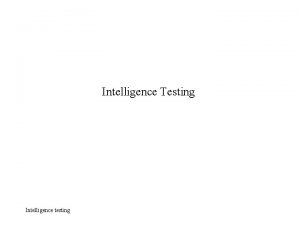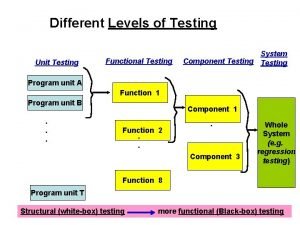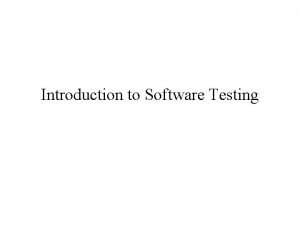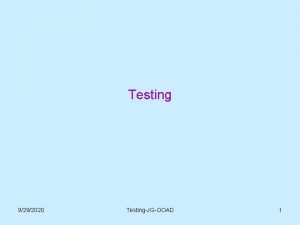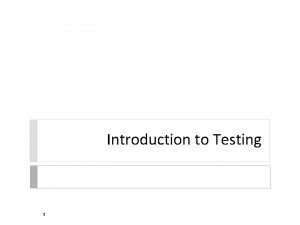INTELLIGENCE AND TESTING WHAT IS INTELLIGENCE Intelligence is


















































- Slides: 50

INTELLIGENCE AND TESTING


WHAT IS INTELLIGENCE? • Intelligence is the ability to: • Learn from experience • Solve problems • Use knowledge to adapt to new situations • Psychologists believe intelligence is a concept, not a thing. • When we think of intelligence as a trait (thing) we make an error called reification — viewing an abstract immaterial concept as if it were a concrete thing.

Key Concepts in Intelligence Testing

PRINCIPAL TYPES OF TESTS • Intelligence tests measure general mental ability. • Two types of intelligence tests: • 1. aptitude tests: designed to measure potential of the test taker; predict how they will perform in the future • Ex. ACT, SAT • 2. achievement tests: gauge a person’s mastery and knowledge of various subjects • Ex. Driver’s test, EOCT, AP Exam

STANDARDIZATION • Intelligence tests are standardized: the uniform procedures used in the administration and scoring of a test • To enable meaningful comparisons, test-makers first give the test to a sample of people. • Individuals who later take the same test have their scores compared to the initial (standard) set of scores. • These standard scores are updated periodically. • In other words, standardized tests tell you how you score relative to other test takers.

PERCENTILE SCORES • Percentile score: indicates the percentage of people who score the same or higher than the score one has obtained. • Kim scored in the 14 th percentile. • That means Kim scored the same as or higher than 14% of test takers. • Randy scored in the 48 th percentile. • That means Randy scored the same as or higher than 48% of test takers. • Hannah scored in the 97% percentile. • That means Hannah scored the same as or higher than 97% of test takers.

RELIABILITY • A test is reliable when it yields consistent results. • To establish reliability researchers establish different procedures: • 1. Split-half Reliability: Dividing the test into two equal halves and assessing how consistent the scores are. • 2. Reliability using different tests: Using different forms of the test to measure consistency between them. • 3. Test-Retest Reliability: Using the same test on two occasions to measure consistency. • Use the results from these procedures to compute a correlation coefficient; closer to +1. 0, the higher reliability a test has.

VALIDITY • Validity of a test refers to what the test is supposed to measure or predict. • Psychologist focus on three types of validity: • 1. Content Validity: Refers to the extent a test measures a particular behavior or trait. • 2. Predictive Validity: Refers to the function of a test in predicting a particular behavior or trait. • 3. Construct Validity: the extent to which evidence shows that a test measures a particular hypothetical construct.

The Evolution of Intelligence Testing

SIR FRANCIS GALTON • Sir Francis Galton: notable for his studies on genetic influence of intelligence. • In his book Hereditary Genius (1869), Galton concluded that success runs in families because intelligence is passed from generation to generation through genes. • Galton coined the phrase nature vs. nurture to refer to the heredity-environment issue. • Leader in the eugenics movement: belief that only genetically “superior” individuals should reproduce. • Invented the concepts of correlation and percentile test scores as well.

ALFRED BINET • Alfred Binet: (1905) devised a test to identify mentally subnormal children who could benefit from special education programs in France • This test became the 1 st useful test of a general mental ability. • Binet-Simon scale expressed a child’s score in terms of mental age: the chronological age that corresponds to the difficulty of questions a child can answer.

LEWIS TERMAN • Lewis Terman – adapted Binet’s tests as the Stanford-Binet IQ test • Intelligence Quotient (IQ) – a child’s mental age divided by chronological age (created by William Stern) • Promoted the use of widespread intelligence testing. • Famous longitudinal study of gifted children called “The Genetic Study of Genius”.

DAVID WECHSLER • David Wechsler: (1939) created the first high-quality IQ test designed specifically for adults, the Wechsler Adult Intelligence Scale (WAIS) • Two major innovations of the WAIS: • 1. Included non-verbal reasoning skills. • 2. Discarded IQ in favor of a new scoring scheme based on the normal distribution, which is now used by most intelligence tests. • Later developed similar tests for children. (WISC)



CHARLES SPEARMAN • What is the exact structure of intelligence? • Charles Spearman: pioneer in use of factor analysis; correlations among many variables are analyzed to identify closely related clusters of variables • Concluded that all cognitive abilities share an important core factor, which he labeled the “g” factor: a general mental ability.

DINNER PARTY CONVERSATIONS • Divide into groups of no more than 3. • Using at least 3 individuals were just discussed (Galton, Binet, Terman, Weschler and Spearman), create a hypothetical dialogue between and among your chosen “guests”. • Your dialogue must clearly address the contributions/beliefs of each to intelligence and intelligence testing. • Look for commonalities or differences among your guests and address these in your dialogue. • Dialogue must be at least one page in length.

Extremes of Intelligence

INTELLECTUAL DISABILITY • Intellectual disability: (formerly mental retardation) refers to subnormal general mental ability accompanied by deficiencies in adaptive skills • Typically children with an IQ below 70 -75 are deemed intellectually disabled.

LEVELS OF INTELLECTUAL DISABILITY

ORIGINS OF INTELLECTUAL DISABILITY • Many organic conditions can cause mental retardation: • 1. Down syndrome: marked by distinctive physical characteristics (slanted eyes, stubby limbs, thin hair); most cases carry extra chromosome • 2. Phenylketonuria: metabolic disorder caused by inherited enzyme deficiency • 3. Hydrocephaly: excessive accumulation of cerebrospinal fluid in the skull destroys brain tissue

GIFTEDNESS • Definition of giftedness vary considerably. • Gifted children usually have an IQ at or above 130. • Tend to be above average in height, weight, strength, physical health, emotional stability, mental health and social maturity. • However new research of profoundly gifted students (IQ above 180) differ from their normally gifted counterparts; tend to be socially isolated and introverted.

GIFTEDNESS AND ACHIEVEMENT IN LIFE • The vast majority of children selected for gifted programs DO NOT achieve eminence or make genius-like contributions to society. • Whether one becomes an eminent adult (those who make enduring contributions to their fields)depends on three intersecting factors: • 1. high intelligence • 2. high creativity • 3. high motivation


SAVANT SYNDROME • Savant syndrome: rare condition in which people with developmental disorders have one or more areas of expertise, ability, or brilliance that are in contrast with the individual's overall limitations.

Heredity and Environment in Determining Intelligence

EVIDENCE FOR HEREDITY • In order to assess the plausibility of genetic determination of intelligence, researches uses twin studies.

TWIN STUDIES • Identical twin studies: twins from a single fertilized egg share more genetic kinship than fraternal counterparts. • The average correlation between identical twins’ is +. 86, indicating that identical twins tend to be quite similar in intelligence. • Fraternal twins’ average correlation is +. 60. • Even identical twins reared apart tend to have similar intelligence scores.

EVIDENCE FOR ENVIRONMENT • Heredity unquestionably influences intelligence. • But to what extent does life experience shape one’s intelligence?

ADOPTION STUDIES • Adoption studies showcase the influence of environment on intelligence. • Adopted children closely resemble their biological parents in intelligence. • However correlations for adopted children and their adoptive parents are statistically significant and positive. • Also showed that siblings reared together are more similar in intelligence than siblings reared apart.


THE FLYNN EFFECT • Evidence is showing that performance on IQ tests has steadily increased over generations. • This trend has been deemed the “Flynn Effect” named after James Flynn who first noticed the increase on a global scale. • The performance that today would earn you an average score of 100 would have earned you an IQ score of about 125 back in the 1930’s.


CULTURAL DIFFERENCES IN IQ • The age-old nature v. nurture debate lies at the core of a long-running controversy about ethnic differences in IQ score. • The average IQ for many minority groups in the US is somewhat lower (about 10 -15 points) than the average white American. • The controversy concerns why the differences are found. • Are the differences due to the influence of heredity or of environment?

HERITABILITY AS AN EXPLANATION • Some psychologists conclude the discrepancy between racial IQs results from heredity. • Their argument centers on the belief that intelligence is largely genetic in origin and that the heritability of intelligence is roughly 80%. White-Americans Black-Americans Average IQ = 100 Average IQ = 85 Hispanic Americans

ARTHUR JENSEN • Read “New York Times” article on death of Arthur Jensen.

SOCIO-ECONOMIC DISADVANTAGE • Some researchers conclude that environment, not heredity, is the cause of ethic differences in IQ. • Minority students test scores are lower because these students tend to grow up in a disadvantaged environment.

COMPARING SOCIO-ECONOMIC GROUPS • In comparison to middle and upper classes, lower class children are: • More likely to come from large or single-parent families. • Exposed to fewer books and outlets for learning. • Have poorer role models for language development. • Experience less encouragement to work hard on intellectual pursuits. • Attend schools that are underfunded and understaffed. • Grow up in neighborhoods where “street smarts” are more revered than “book smarts”. • Suffer from malnutrition.

STEREOTYPE THREAT • Some researchers maintain that other factors cause lower IQ scores for minorities. • Claude Steel: argued that negative stereotypes of stigmatized groups’ intellectual abilities create feeling of vulnerability in the classroom which he calls the stereotype threat. • Member of minority groups are keenly aware of the negative stereotypes and will in turn attribute their failure to racial inferiority.

New Directions in the Study of Intelligence

BIG BRAIN DEBATE • Does a larger, heavier brain correlate to higher intelligence? • Gray matter: neural density of cell bodies and dendrites; predictive of informationprocessing capabilities • White matter: quantity of axons and their degree of myelin insulation; predicative of the efficiency of neural communication. • Higher intelligence correlates with increased volume of BOTH gray and white matter, with the association being a little stronger for gray.

INTELLIGENCE AND LIFE EXPECTANCY • Recent studies have shown that smarter people live longer! • Studies suggest three possible reasons for this: • 1. Good genes could foster both higher intelligence and resilient health. • 2. Health self-care is a life-long mission for which brighter people are better prepared. • 3. Intelligence fosters career success and higher social status reduces mortality.

ROBERT STERNBERG • Robert Sternberg: focuses his research on how people use their intelligence. • Asserts that three facets characterize what he calls the “triarchic theory”: • 1. analytical intelligence: abstract reasoning, evaluation and judgment • 2. creative intelligence: ability to generate new ideas and be inventive in dealing with novel problems • 3. practical intelligence: application and use for everyday tasks



HOWARD GARDNER • Howard Gardner: believed that IQ tests emphasize verbal and mathematical skills to the exclusion of other important skills. • Created his list of multiple intelligences: • 1. Verbal-Linguistic • 2. Logical- Mathematical • 3. Bodily-Kinesthetic • 4. Visual-Spatial • 5. Musical-Rhythmic • 6. Interpersonal • 7. Intrapersonal • 8. Naturalistic



 Positive testing vs negative testing
Positive testing vs negative testing Static testing and dynamic testing
Static testing and dynamic testing What is domain
What is domain Motivational overview of logic based testing
Motivational overview of logic based testing Data flow testing strategies in software testing
Data flow testing strategies in software testing Anuj magazine
Anuj magazine Neighborhood integration testing
Neighborhood integration testing Cause effect graphing technique
Cause effect graphing technique Control structure testing in software testing
Control structure testing in software testing Decision table testing in software testing
Decision table testing in software testing Decision table technique
Decision table technique Contoh pengujian equivalence partitioning
Contoh pengujian equivalence partitioning Behavior testing adalah
Behavior testing adalah Extended entry decision table
Extended entry decision table Rigorous testing in software testing
Rigorous testing in software testing Testing blindness in software testing
Testing blindness in software testing Component testing is a black box testing
Component testing is a black box testing Types of domain testing
Types of domain testing A survey of the history of intelligence testing reinforces
A survey of the history of intelligence testing reinforces Audience intelligence testing
Audience intelligence testing Intelligence testing
Intelligence testing Intelligence testing
Intelligence testing Software testing and quality assurance: theory and practice
Software testing and quality assurance: theory and practice The quality revolution
The quality revolution Software testing and quality assurance theory and practice
Software testing and quality assurance theory and practice Software testing and quality assurance theory and practice
Software testing and quality assurance theory and practice Quality assurance theory
Quality assurance theory B.i.ø
B.i.ø Ut testing principle
Ut testing principle State bugs in software testing
State bugs in software testing People and organizational issues in testing
People and organizational issues in testing Hypothesis testing
Hypothesis testing Chapter 6 employee testing and selection ppt
Chapter 6 employee testing and selection ppt Bracketing and matrixing designs for stability testing
Bracketing and matrixing designs for stability testing Employee testing and selection
Employee testing and selection Employee testing and selection summary
Employee testing and selection summary Employee testing and selection
Employee testing and selection Digital systems testing and testable design
Digital systems testing and testable design Cs 527 uiuc
Cs 527 uiuc What is computer aided testing
What is computer aided testing Combinational circuit design and simulation using gates
Combinational circuit design and simulation using gates Chapter 34 collecting and testing specimens
Chapter 34 collecting and testing specimens Chapter 30 inspecting and testing welds
Chapter 30 inspecting and testing welds Unit-6
Unit-6 Destructive and nondestructive testing of welds
Destructive and nondestructive testing of welds Controllability and observability in vlsi testing
Controllability and observability in vlsi testing Schwartz-zippel lemma and polynomial identity testing
Schwartz-zippel lemma and polynomial identity testing Dfwo and dfwr full form
Dfwo and dfwr full form Essay-translation approach example
Essay-translation approach example Testing of hypothesis
Testing of hypothesis Testing grammar and vocabulary
Testing grammar and vocabulary




















